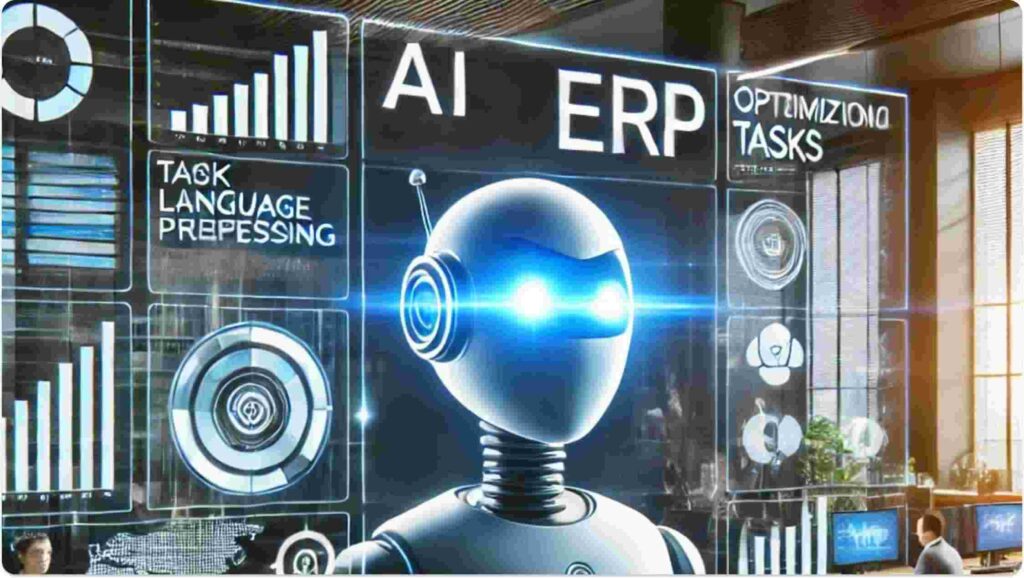Increasingly, businesses are under pressure to simplify operations, boost efficiency, and deliver real-time insights. Traditional ERP systems, while powerful, are often cumbersome and unintuitive. ERP AI chatbots provide a solution by introducing conversational simplicity to complex enterprise workflows.
In this blog, we’ll explore what ERP AI chatbots are, how they can transform your business, what makes a chatbot effective, and how to build one that truly meets your enterprise needs.
Understanding ERP AI Chatbots: Definition and Core Concepts
According to Golden Owl, an ERP AI chatbot is an intelligent conversational interface designed to interact with an organization’s Enterprise Resource Planning (ERP) system. It combines the capabilities of artificial intelligence (AI), machine learning (ML), and natural language processing (NLP) to simplify and automate how users access and interact with ERP functionalities.
Traditional ERP systems are powerful but often complex, requiring users to navigate multiple modules, dashboards, and menus to retrieve information or execute commands. An ERP AI chatbot eliminates this friction by enabling users to interact with the system through everyday language, either via text or voice. Instead of logging into the ERP, navigating to the procurement module, and manually updating inventory levels, a user can simply ask, “What’s the current stock level for product X?” or say, “Place a restock order for 500 units.”
ERP AI chatbots are typically deployed across messaging platforms such as Microsoft Teams, Slack, or embedded into mobile and web applications. They can handle a variety of use cases, from HR self-service and financial approvals to customer order tracking and sales insights.
Key Business Advantages of Implementing ERP AI Chatbots
Adopting ERP AI chatbots offers numerous advantages that can significantly impact both operational efficiency and strategic decision-making. These benefits include:

Streamlined Operations
Chatbots accelerate task completion by providing instant access to ERP functions. Whether it’s generating reports, updating records, or processing approvals, these interactions take seconds instead of minutes or hours. This leads to reduced process delays and optimized workflows across departments.
Enhanced Accessibility and Usability
ERP systems are often underutilized due to their steep learning curve. By translating complex functions into simple dialogues, chatbots make ERP systems more accessible to non-technical users, encouraging wider adoption across the organization.
Faster Problem-Solving
ERP AI chatbots significantly reduce the time required to identify and resolve issues. Employees no longer need to wait for IT support or manually dig through modules to find relevant data. Instead, they can ask the chatbot direct questions such as “Why was this invoice rejected?” or “Which purchase orders are still pending approval?” and receive instant answers, enabling faster resolution and minimizing workflow disruptions. This real-time support capability is especially critical in high-pressure environments like supply chain management, finance, or customer service.
Improved Employee Productivity
By automating routine and repetitive tasks, employees can focus on higher-value activities. For example, an HR specialist can offload FAQs about leave policies to a chatbot and instead focus on strategic talent management.
Real-Time Decision Support
With access to real-time ERP data, chatbots can provide instant answers to critical business questions. For example, a sales manager might ask the chatbot for current revenue performance or pipeline forecasts during a meeting, enabling faster and more informed decisions.
Cost Optimization
Reducing dependency on IT support or administrative staff for basic ERP operations lowers overhead costs. In high-volume environments, this cost efficiency can scale considerably.
Better Customer and Employee Experience
For both internal users and external stakeholders, a chatbot enhances the experience by providing quick, accurate, and personalized responses around the clock, without requiring human intervention.
Essential Factors Behind a High-Performing ERP AI Chatbot
Not all ERP AI chatbots are created equal. To deliver real business value, a chatbot must go beyond basic automation and become a reliable, context-aware assistant embedded within daily operations. Below are two of the most critical success factors:

Choose the Right AI and NLP Platform
The foundation of a successful ERP AI chatbot lies in the AI engine that powers it. Selecting a robust AI and natural language processing (NLP) platform ensures that the chatbot can understand diverse inputs, recognize user intent accurately, and respond intelligently in real time.
The ideal platform should support:
- Advanced intent classification and entity recognition,
- Context tracking for multi-turn conversations,
- Continuous learning and model improvement,
- Easy integration with ERP APIs and enterprise systems,
- Multilingual capabilities are required for operating across regions.
Popular platforms such as OpenAI, Microsoft Azure Cognitive Services, Google Dialogflow, or IBM Watson provide enterprise-grade NLP and are well-suited for ERP-scale applications. The chosen platform must also meet your organization’s data privacy, scalability, and customization requirements.
Design Natural and Task-Oriented Conversations
A chatbot is only as effective as its ability to understand and communicate like a human. Designing intuitive, natural conversation flows is essential for maximizing usability and user satisfaction.
When crafting dialogue, consider the following:
- Use familiar business language that mirrors how users speak,
- Keep messages concise, action-oriented, and free from technical jargon.
- Guide users step by step through complex tasks using structured prompts,
- Anticipate variations in phrasing, misspellings, and abbreviations,
- Include fallback responses and escalation paths when needed.
Contextual awareness is also key. The chatbot should remember past inputs in a session, clarify ambiguous questions, and adjust its responses based on user roles or permissions within the ERP system.
Ultimately, the goal is to make interactions feel seamless and efficient, allowing users to get things done quickly without switching between modules, forms, or screens.
A Step-by-Step Guide to Developing a Powerful ERP AI Chatbot
Developing an ERP AI chatbot requires a strategic and phased approach. Below is a six-step guide to help ensure success:

Step 1: Define Objectives and Use Cases
Start by identifying the pain points or inefficiencies in your current ERP workflows. Focus on high-impact, repetitive tasks that can be automated through conversation. Common use cases include timesheet entry, procurement requests, sales inquiries, and financial report generation.
Define clear KPIs such as reduction in task completion time, user adoption rate, or reduction in support tickets.
Step 2: Select the Right Technology Stack
Choose a combination of chatbot development frameworks, AI/NLP platforms, and ERP systems that support interoperability. For example:
- Chatbot Platform: Microsoft Bot Framework, Google Dialogflow, Rasa
- AI/NLP Layer: OpenAI, Amazon Lex, IBM Watson
- ERP System: SAP, Oracle ERP Cloud, Microsoft Dynamics, Odoo, NetSuite
Ensure the chosen stack supports real-time communication, API integrations, and user access control.
Step 3: Design Intelligent Conversation Flows
Build conversational flows that mimic real user interactions. Design for clarity, brevity, and task completion. Include fallback options and escalation paths to human agents for unresolved queries.
Focus on natural phrasing and support synonyms, abbreviations, and multilingual phrases. Use user personas and scenario modeling to guide dialogue design.
Step 4: Integrate with ERP Backend
Establish secure connections to ERP modules using APIs, webhooks, or ERP middleware tools. Map out which fields and data points the chatbot can access or update and implement role-based permissions to restrict access.
Thoroughly test integrations in a sandbox environment before deploying to production.
Step 5: Test, Train, and Collect Feedback
Before going live, conduct rigorous testing with real users across departments. Track how well the chatbot understands queries, executes tasks, and handles errors.
Gather user feedback during this phase and use it to train and fine-tune the NLP models. Consider launching in phases, such as pilot, department-wide, and then enterprise-wide.
Step 6: Monitor Performance and Iterate
After deployment, monitor usage analytics such as session volume, resolution rate, user satisfaction, and task completion time. Set up dashboards to detect anomalies and improvement areas.
Schedule regular updates to add new intents, improve accuracy, and enhance capabilities based on evolving business needs and user behavior.
Final Thoughts
Implementing a high-performance ERP AI chatbot can transform how your business interacts with complex enterprise systems, driving efficiency, improving problem-solving speed, and enhancing overall user experience. By choosing the right AI platform and designing natural, task-focused conversations, your chatbot will become an indispensable assistant for your teams.
At Sphinx, we specialize in developing cutting-edge AI solutions tailored to integrate seamlessly with your ERP systems, helping you unlock new levels of productivity and operational agility.
Ready to elevate your ERP experience with a powerful AI chatbot? Contact Sphinx today to discover how our expertise can help you build and deploy a solution that meets your unique business needs.




CEO - Son Le
OTHER BLOGS
Blogs
AI Driving Innovation: Key Impacts, Challenges and Market Trends
Artificial Intelligence is rapidly moving from a supportive capability to a central engine of innovation across modern enterprises. Its advancements in automation, generative modeling and real time analytics are redefining how organizations operate, scale and deliver value. As AI becomes embedded into products, workflows and strategic decisions, it is reshaping...
Read MoreBlogs
Top 10 Countries for IT Outsourcing in 2026
IT outsourcing is becoming an increasingly popular strategy as businesses worldwide seek to accelerate digital transformation, reduce operational costs, and access specialized tech talent. With the rapid growth of cloud computing, AI, and software development demands, more companies are turning to global partners to stay competitive and scale efficiently. In...
Read MoreBlogs
Transform Your Business with SAP Consulting Support
In today’s digital-first landscape, enterprise systems must evolve continuously to keep up with rising customer expectations, data complexity, and the demand for operational excellence. SAP plays a central role in this transformation, offering intelligent, integrated solutions that help organizations modernize their operations and drive long-term growth. However, SAP only delivers...
Read MoreOTHER BLOGS
Our Sevices
IoT Development
SphinX offers cutting-edge IoT development services, seamlessly connecting devices and providing innovative solutions for a...
Xem thêmOur Sevices
Blockchain Development
We are highly proficient in engineering reliable and secure blockchain technologies from the ground up,...
Xem thêmOur Sevices
ERP & CRM Development
ERP & CRM development services that you need! Streamline business processes and enhance organizational efficiency....
Xem thêmOTHER BLOGS
Our Sevices
IoT Development
SphinX offers cutting-edge IoT development services, seamlessly connecting devices and providing innovative solutions for a...
Xem thêmOur Sevices
Blockchain Development
We are highly proficient in engineering reliable and secure blockchain technologies from the ground up,...
Xem thêmOur Sevices
ERP & CRM Development
ERP & CRM development services that you need! Streamline business processes and enhance organizational efficiency....
Xem thêm